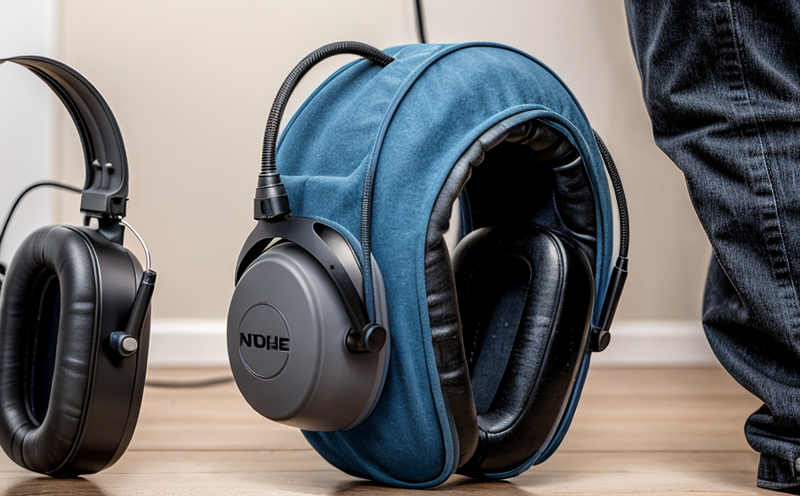ANSI S12.42 Hearing Protector Insertion Loss Testing
The ANSI S12.42 hearing protector insertion loss test is a critical procedure for ensuring that hearing protection devices (HPDs) effectively reduce noise exposure in occupational settings. This test evaluates the performance of HPDs by measuring their ability to attenuate sound, thereby protecting workers from hazardous noise levels.
The ANSI S12 series of standards are recognized globally and are used to ensure that hearing protectors meet specific performance criteria. The insertion loss test is particularly important in industries such as manufacturing, construction, and mining where employees are exposed to high noise levels on a regular basis. Compliance with these standards helps employers reduce the risk of noise-induced hearing loss (NIHL) among their workforce.
The test involves placing the HPD over a reference ear canal model and measuring the sound pressure level at both the outside and inside of the ear canal. The difference between the two measurements is known as the insertion loss, which quantifies how much noise reduction the protector provides. This value is then compared against the standards set by ANSI S12.42 to determine compliance.
The apparatus used in this test includes a sound source capable of producing broadband white noise over a wide frequency range, an ear canal model that mimics the geometry and acoustical properties of human ears, and a measuring device such as a sound level meter. The HPD is worn correctly on the ear canal model according to manufacturer instructions.
The test procedure ensures that all aspects contributing to noise reduction are accounted for, including the fit of the protector, its design characteristics, and environmental factors. Compliance with ANSI S12.42 not only protects workers but also helps companies meet regulatory requirements and improve their safety culture.
Real-world applications of this test include certifying new HPD models for market release, validating existing products to ensure ongoing compliance, and ensuring that modifications or adjustments to existing protectors do not compromise their effectiveness. This testing is a crucial step in the development and quality assurance processes of protective equipment manufacturers.
- Ensures worker safety by reducing noise-induced hearing loss
- Maintains compliance with international standards (ANSI S12.42)
- Validates product performance across a range of noise environments
- Supports continuous improvement in protective equipment design
Scope and Methodology
The ANSI S12.42 hearing protector insertion loss test is designed to assess the noise reduction properties of earplugs, earmuffs, and other types of HPDs in accordance with ANSI S12 standards. The methodology involves a series of steps that ensure accurate and consistent results.
First, the sound source produces broadband white noise over a wide frequency range, typically between 50 Hz to 8 kHz. This ensures that the test covers all relevant frequencies that can be harmful to human hearing. The ear canal model is then placed in the sound field, and the HPD is fitted correctly onto the model.
The sound level meter measures the sound pressure levels at both the outside of the ear canal (ambient noise) and inside the ear canal (noise with protector). The difference between these two measurements gives the insertion loss value. This process is repeated for various types of HPDs to compare their performance accurately.
The test also considers factors such as the fit of the protector, which can significantly affect its noise reduction capabilities. Proper fitting ensures that all sound waves are blocked effectively, leading to higher insertion loss values and better protection against hazardous noise levels.
Compliance with ANSI S12.42 requires that the test results meet or exceed specified thresholds for different types of HPDs under various conditions. This includes testing at different sound pressure levels and in different acoustic environments to ensure broad applicability.
Quality and Reliability Assurance
The quality and reliability of ANSI S12.42 hearing protector insertion loss testing are paramount for ensuring that the results accurately reflect the performance of the protectors. Our laboratory adheres to strict protocols and uses state-of-the-art equipment to ensure accurate and reliable data.
Our team of experts performs rigorous quality checks at every stage of the testing process, from specimen preparation to final analysis. This includes calibrating all instruments before each test run and maintaining a clean and controlled environment to minimize external variables that could affect results.
We also employ advanced software for data analysis, which helps in identifying any inconsistencies or outliers. Our commitment to quality is further demonstrated through our participation in inter-laboratory comparisons, ensuring consistency across different testing facilities.
Reliability is maintained by consistently applying the same standards and methodologies. This ensures that the results are repeatable and can be trusted for regulatory submissions or internal audits. By focusing on precision and accuracy, we provide clients with confidence in their data and decision-making processes.





